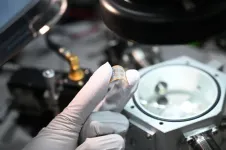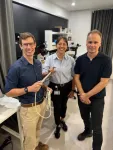(Press-News.org) The research team led by Dr. Jongwon Yoon, Dr. Jeongdae Kwon, and Dr. Yonghoon Kim from the Energy & Environmental Materials Research Division at the Korea Institute of Materials Science (KIMS), has successfully developed the world’s first ammonia (NH₃) gas sensor based on a copper bromide (CuBr) film that can be fabricated through a simple solution process at low temperatures. This breakthrough technology not only enables sensor flexibility, ultra-sensitivity, and high selectivity but also significantly reduces manufacturing costs.
Ammonia gas sensors detect airborne ammonia and are utilized in indoor and outdoor environmental monitoring, hazardous gas detection in industrial settings, and disease diagnosis. The copper bromide (CuBr) film used in the sensor exhibits a significant change in electrical resistance upon exposure to ammonia, enabling the detection of even low concentrations of the gas.
In conventional methods, forming the copper bromide (CuBr) film required for the sensor necessitated a high-temperature vacuum process above 500°C. This posed challenges in applying it to flexible substrates, which are vulnerable to heat, and also led to high production costs. To address this issue, the research team developed a technique to form a two-dimensional copper nanosheet on a substrate at a temperature below 150°C without a vacuum process. They then synthesized the copper bromide film through a simple solution-based process. As a result, they successfully implemented an ammonia gas sensor on a plastic substrate.
This study successfully developed a highly sensitive sensor capable of detecting ammonia concentrations as low as one part per million (ppm) using a low-temperature solution-based process. This breakthrough significantly reduces manufacturing costs and offers potential applications in wearable sensors and diagnostic medical devices. Furthermore, experimental tests involving over 1,000 repeated bending cycles confirmed that the sensor maintained high performance and operated with stable functionality.
Dr. Jongwon Yoon, the lead researcher, stated, “The ammonia sensor developed through this study has great potential for expansion into flexible and wearable devices. It can be utilized in a wide range of applications, from indoor air quality monitoring to personal health management.”He further emphasized, “In particular, we expect that it could be applied as a disease diagnosis sensor by attaching it to the human body to analyze exhaled breath.”
The research was conducted in collaboration with Professor Tae-Wook Kim from Jeonbuk National University and Professor Hong Seung Kim from Korea Maritime & Ocean University. This study was supported by the Global TOP Project of the National Research Council of Science & Technology (NST), the Nano and Material Technology Development Program of the National Research Foundation of Korea (NRF), and fundamental projects of the Korea Institute of Materials Science (KIMS). The findings were published online on March 6 in Sensors and Actuators B: Chemical (Impact Factor: 8.0, JCR Top 0.7%), a globally renowned academic journal. The research team is continuing further studies to enhance productivity by developing large-area film-based applications.
-----------------------------------------------------------------------
###
About Korea Institute of Materials Science(KIMS)
KIMS is a non-profit government-funded research institute under the Ministry of Science and ICT of the Republic of Korea. As the only institute specializing in comprehensive materials technologies in Korea, KIMS has contributed to Korean industry by carrying out a wide range of activities related to materials science including R&D, inspection, testing&evaluation, and technology support.
END
Even after a thousand bends, performance remains uncompromised!
KIMS developed the world's first highly flexible and ultra-sensitive ammonia sensor technology based on a low-temperature synthesized copper bromide film
2025-04-08
ELSE PRESS RELEASES FROM THIS DATE:
Survey: Women’s perceptions of perimenopause
2025-04-08
Hot flashes, mood swings, weight gain and insomnia are all signs of hormonal changes and symptoms of menopause, when a woman no longer has menstrual cycles. They can also signal perimenopause, when the body is preparing for this next season of life.
“Perimenopause is when the menstrual cycle has started to change, and it is persistent,” explained Lauren Baker, DO, an obstetrics and gynecology physician at The Ohio State University Wexner Medical Center and certified practitioner with the Menopause Society. “The formal definition is periods fluctuate by at least seven days for at least 10 months.”
A new survey by Ohio State ...
Singapore scientists pioneer non-invasive 3D imaging to transform skin cancer management
2025-04-08
SINGAPORE – Researchers from the Agency for Science, Technology and Research (A*STAR) and the National Healthcare Group (NHG) have jointly pioneered an innovative imaging technique combining Multispectral Optoacoustic Tomography (MSOT) with artificial intelligence (AI) that could significantly improve the diagnosis and treatment of basal cell carcinoma (BCC), the most common form of skin cancer worldwide.
This advanced technique uses photoacoustic imaging (PAI), enhanced by an automated segmentation algorithm, to provide real-time, high-resolution, three-dimensional (3D) images of skin tumours. By accurately mapping tumour boundaries, ...
Powerful new tool promises major advances in cancer treatment
2025-04-08
New Australian technology is set to transform the way that gastrointestinal cancers are detected and treated with precise, minimally invasive surgery.
Backed by the Federal Government’s Economic Accelerator (AEA) Ignite Grant, researchers from the University of South Australia (UniSA) are using quantum technology to develop a first-of-its-kind laparoscopic probe that will allow surgeons to accurately map the spread of tumours.
The technology has the potential to improve cancer survival rates and patient quality of life worldwide.
Led by Dr Nicole Dmochowska from UniSA’s ...
Inflammation and the brain: how immune activity can alter mood and fuel anxiety
2025-04-08
FOR IMMEDIATE RELEASE
Physicians have long observed a mystifying phenomenon: After a bout of infection or an autoimmune disease flare-up, some people experience prolonged mood swings, emotional dysregulation, and changes in behavior. But the precise connection between inflammation, mood, and behavior has remained elusive.
Now, two new studies from Harvard Medical School and Massachusetts Institute of Technology, published April 7 in Cell, detail the steps of an intricate brain-immune crosstalk that accounts for this long-known but poorly understood observation.
The work, conducted ...
Researchers demonstrate the UK’s first long-distance ultra-secure communication over a quantum network
2025-04-07
Researchers have successfully demonstrated the UK’s first long-distance ultra-secure transfer of data over a quantum communications network, including the UK’s first long-distance quantum-secured video call.
The team, from the Universities of Bristol and Cambridge, created the network, which uses standard fibreoptic infrastructure, but relies on a variety of quantum phenomena to enable ultra-secure data transfer.
The network uses two types of quantum key distribution (QKD) schemes: ‘unhackable’ encryption keys hidden inside particles of light; and distributed entanglement: a phenomenon that causes quantum particles to be intrinsically ...
One in 3,000 people at risk of punctured lung from faulty gene – almost 100 times higher than previous estimate
2025-04-07
As many as one in 3,000 people could be carrying a faulty gene that significantly increases their risk of a punctured lung, according to new estimates from Cambridge researchers. Previous estimates had put this risk closer to one in 200,000 people.
The gene in question, FLCN, is linked to a condition known as Birt-Hogg-Dubé syndrome, symptoms of which include benign skin tumours, lung cysts, and an increased risk of kidney cancer.
In a study published today in the journal Thorax, a team from the University of Cambridge examined data from UK Biobank, the 100,000 Genomes Project, and East London Genes & Health – three large genomic datasets encompassing more than ...
Creativity and problem-solving: How design thinking transforms university teaching
2025-04-07
Thinking creatively, solving complex problems, and working in teams… all add up to Design Thinking (DT). A study conducted by the Escuela Superior Politécnica del Litoral (ESPOL) and Ghent University provides a step-by-step guide for teaching this methodology as a university course.
The main objective of this study is to share the implementation of DT in the first year of all undergraduate programs at ESPOL, considering that previous research has shown that this course fosters essential DT skills in a world of constant change, allowing students to build their own knowledge through experiential learning.
In practice, this study ...
American College of Cardiology recognizes 2025 Young Investigator Award recipients
2025-04-07
The American College of Cardiology is recognizing the 2025 winners of its Young Investigator Awards, which took place at the ACC’s Annual Scientific Session (ACC.25) in Chicago.
The Young Investigator Awards competition invites promising, young scientific investigators to present their cutting-edge research. The finalists competed in three categories: Basic and Translational Science, Clinical Investigations and Outcomes Research. This year’s awardees are:
Young Investigator Awards in Basic ...
Coding differences in Medicare Advantage plans led to $33 billion in excess revenue to insurers
2025-04-07
Embargoed for release until 5:00 p.m. ET on Monday 7 April 2025
Follow @Annalsofim on X, Facebook, Instagram, threads, and Linkedin
Below please find summaries of new articles that will be published in the next issue of Annals of Internal Medicine. The summaries are not intended to substitute for the full articles as a source of information. This information is under strict embargo and by taking it into possession, media representatives are committing to the ...
CAS and Cleveland Clinic collaborate to accelerate research through advanced AI and quantum computing
2025-04-07
Columbus, OH; Cleveland, OH, April 7, 2025 – CAS, a division of the American Chemical Society specializing in scientific content and knowledge management, and Cleveland Clinic, an academic health system with a global footprint, announced plans for a strategic collaboration that will unite the organizations’ unique expertise, technology, and data capabilities to fuel clinical research.
During the Cleveland Discovery & Innovation Forum, an event highlighting cutting-edge healthcare and life sciences research, the two global organizations announced that their collaboration’s ...
LAST 30 PRESS RELEASES:
Scientists use ultrasound to soften and treat cancer tumors without damaging healthy tissue
Community swimming program for Black youth boosts skills, sense of belonging, study finds
Specific depressive symptoms in midlife linked to increased dementia risk
An ‘illuminating’ design sheds light on cholesterol
Who is more likely to get long COVID?
Study showcases resilience and rapid growth of “living rocks”
Naval Research Lab diver earns Office of Naval Research 2025 Sailor of the Year
New Mayo-led study establishes practical definition for rapidly progressive dementia
Fossil fuel industry’s “climate false solutions” reinforce its power and aggravate environmental injustice
Researchers reveal bias in a widely used measure of algorithm performance
Alcohol causes cancer. A study from IOCB Prague confirms damage to DNA and shows how cells defend against it
Hidden viruses in wastewater treatment may shape public health risks, study finds
Unlock the power of nature: how biomass can transform climate mitigation
Biochar reshapes hidden soil microbes that capture carbon dioxide in farmland
Reducing saturated fat intake shows mortality benefit, but only in high-risk individuals
Manta rays create mobile ecosystems, study finds
Study: Mixed results in using lipoic acid to treat progressive multiple sclerosis
Norbert Holtkamp appointed director of Fermi National Accelerator Laboratory
New agentic AI platform accelerates advanced optics design
Biologists discover neurons use physical signals — not electricity — to stabilize communication
Researchers discover that a hormone can access the brain by hitchhiking
University of Oklahoma researcher awarded funding to pursue AI-powered material design
Exploring how the visual system recovers following injury
Support for parents with infants at pediatric check-ups leads to better reading and math skills in elementary school
Kids’ behavioral health is a growing share of family health costs
Day & night: Cancer disrupts the brain’s natural rhythm
COVID-19 vaccination significantly reduces risk to pregnant women and baby
The role of vaccination in maternal and perinatal outcomes associated with COVID-19 in pregnancy
Mayo Clinic smartwatch system helps parents shorten and defuse children's severe tantrums early
Behavioral health spending spikes to 40% of all children’s health expenditures, nearly doubling in a decade
[Press-News.org] Even after a thousand bends, performance remains uncompromised!KIMS developed the world's first highly flexible and ultra-sensitive ammonia sensor technology based on a low-temperature synthesized copper bromide film



